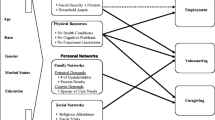Abstract
This study examined the differences between adults selected for an agency's new initiative in using person centered planning with adults who remained on the waiting list for this service. A total of 45 adults participated in this research, 22 of whom received person centered planning and 23 of whom remained on a waiting list. Participant interviews were conducted using the Residential Lifestyle Inventory and the Social Network Analysis Form. Individuals selected first for person centered planning had significantly higher scores on several categories of these inventories. The agency case managers were then surveyed to determine variables that influenced selection for services. Case managers reported that participants' self advocacy for a new job had the strongest influence on their selection of the first participants for person centered planning. A few cases were strongly influenced by other advocates, a crisis situation, or administrators. Implications of determining selection criteria when the need for services exceeds available resources are discussed based on the outcomes of this research.
Similar content being viewed by others
REFERENCES
Affleck, J. Q., Edgar, E., Levine, Pl, and Kortering, L. (1990). Post-school status of students classified as mildly mentally retarded, learning disabled, or nonhandicapped: Does it get better with time? Ed. Train. Ment. Retard. 25: 315–324.
Bewley, C., and Glendinning, C. (1994). Representing the views of disabled people in community care planning. Dis. Soc. 9: 301–314.
Braddock, D. (1994). Presidential address 1994: New frontiers in mental retardation. Ment. Retard. 32: 434–443.
Chapin, R., and Rotegard, L. (1993). Day training and habilitation reimbursement: A target approach. J. Dis. Pol. Studies 4: 65–88.
Faw, G., Davis, P., and Peck, C. (1996). Increasing self-determination: Teaching people with mental retardation to evaluate residential options. J. Appl. Behav. Anal. 29: 173–188.
Foxx, R. M., Faw, G., Taylor, S., and Davis, P. (1993). Would I be able to...? Teaching clients to assess the availability of their community living life style preferences. Am. J. Ment. Retard. 98: 235–248.
Heinlein, K. B., and Fortune, J. (1995). Who stays, Who goes? Downsizing the institution in America's most rural state. Res. Devel. Disabil. 16: 165–177.
Kennedy, C. H., Horner, R. H., Newton, J. S., and Kanda, E. (1990). Measuring the activity patterns of adults with severe disabilities using the Residential Lifestyles Inventory. J. Assoc. Pers. Sev. Hand. 15: 79–85.
Morningstar, M. E., Turnbull, A. P., and Turnbull, H. R. (1996). What do students with disabilities tell us about the importance of family involvement in the transition from school to adult life? Except. Child. 62: 249–260.
Mount, B. (1994). Benefits and limitations of personal futures panning. In Bradley, V. J., Ashbaugh, J. W., and Blaney, B. C. (eds.), Creating Individual Supports for People with Developmental Disabilities, Baltimore, MD, Paul H. Brookes, pp. 97–108.
O'Brien, J. (1987). A guide to lifestyle planning. In Bellamy, T., and Wilcox, B. (eds.), The Activities Catalog: A Community Programming Guide for Youth and Adults with Severe Disabilities. Paul H. Brookes, Baltimore, pp 75–189.
Newton, J., Bellamy, G. T., Horner, R., Boles, S., LeBaron, N., and Bennett, A. (1987). Using the Activities Catalogue in residential programs for individuals with severe disabilities. In Wilcox, B., and Bellamy, G. T. (eds.), A Comprehensive Guide to the Activities Catalogue: An Alternative Curriculum for Youth and Adults with Severe Disabilities, Baltimore, Paul H. Brookes, pp. 125–153.
Salkever, D. (1994). Access to vocational rehabilitation services for persons with severe disabilities: Analysis of the 1990 Developmental Disabilities National Consumer Survey. J. Dis. Pol. Studies 5: 45–64.
Wehmeyer, M. L. (1994). Employment status and perceptions of control of adults with cognitive and developmental disabilities. Res. Devel. Disabil. 15: 119–131.
Wehmeyer, M. L., and Metzler, C. A. (1995). How self-determined are people with mental retardation? The national consumer survey. Ment. Retard. 33: 111–119.
West, M. D., and Parent, W. S. (1992). Consumer choice and empowerment in supported employment services: Issues and strategies. J. Assoc. Pers. Sev. Hand. 17: 47–52.
Wolfe, P. S., Ofiesh, N. S., and Boone, R. B. (1996). Self-advocacy preparation of consumers with disabilities: A national perspective of ADA training efforts. J. Assoc. Pers. Sev. Hand. 21: 81–87.
Author information
Authors and Affiliations
Rights and permissions
About this article
Cite this article
Browder, D.M., Cooper, K.J., DaCosta, J. et al. An Evaluation of Variables that Influence the Selection of Participants for Innovative Services. Journal of Developmental and Physical Disabilities 11, 47–59 (1999). https://doi.org/10.1023/A:1021860618267
Issue Date:
DOI: https://doi.org/10.1023/A:1021860618267




